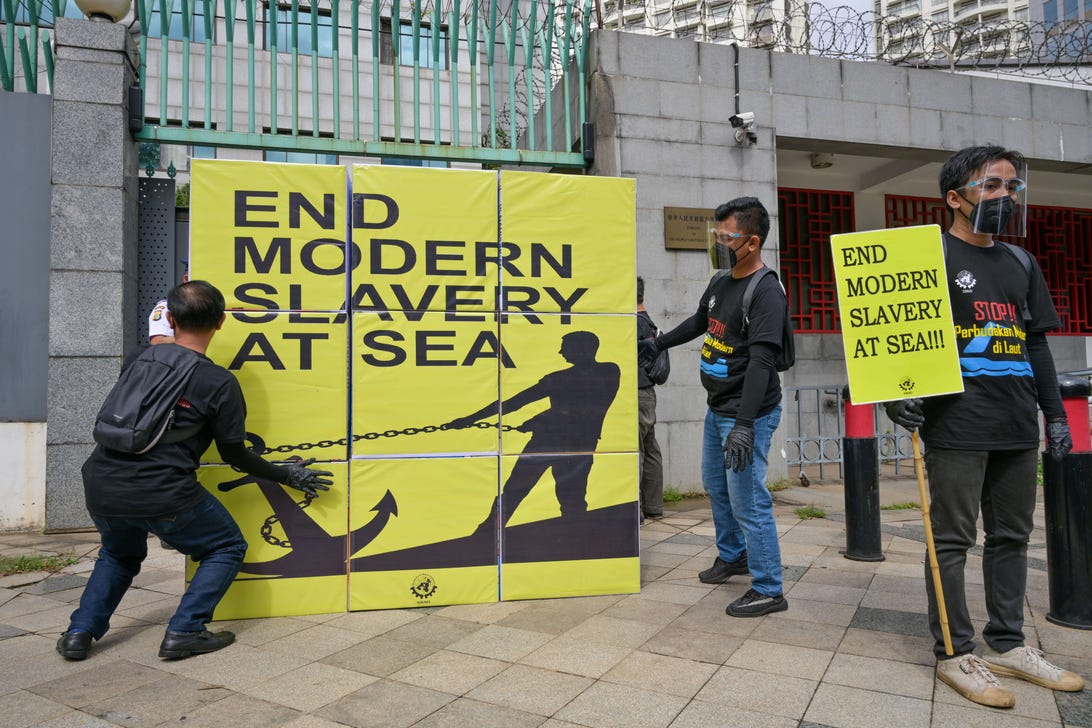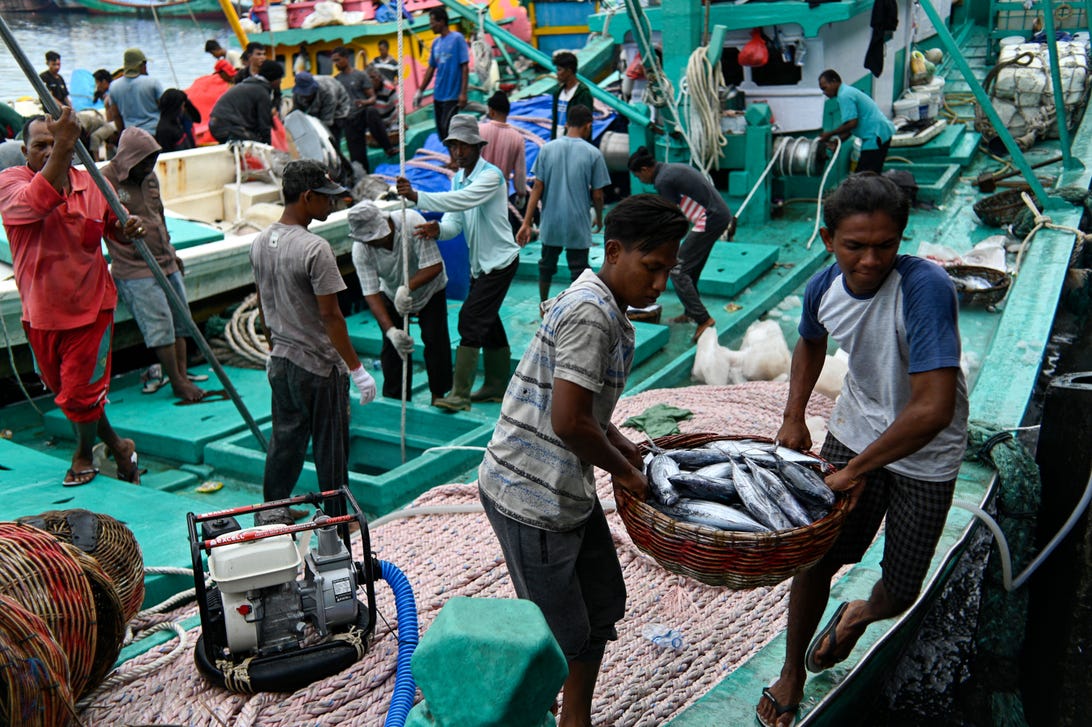
Workers help unload fish at a port in Thailand.
Paula Bronstein/Getty Images
In 2015, more than 2,000 fishermen were rescued from slavery on an island in eastern Indonesia.
For years they were subjected to depraved working conditions. Many reported being beaten with stingray tails, beaten and starved, while being forced to contribute to a seafood supply chain that trickled down to major brands, including retailers, supermarket chains and pet food makers. They were not paid for their labor.
It wasn’t until seven years ago, after an Associated Press investigation revealed the truth, that these formerly enslaved workers were released, miraculously reunited with their families, and provided aid in the United States.
It was a heartbreaking story, but one that only represents a fraction of the fishermen facing labor abuse across the seas.
In a paper published Tuesday in the journal Nature Communications, Stanford researchers quantified how deep such abuses — and other illegal practices, such as fishing in zones intended to protect wildlife — run into the global marine sector. Their results are shocking.
After examining 792 fishing ports, they found that 57% were linked to labor abuse or illegal fishing, and often both. And after analyzing more than 8 million fishing trips between 2012 and 2019 that ended in these ports, they found that 82% were also associated with work abuse and illegal fishing. By isolating labor abuse, they found more than 41% of the ports surveyed specifically related to it.
These conclusions are thanks to a machine learning model that combined a database that tracked fishing vessels worldwide with first-hand accounts of fishing crimes from research institutions, companies, human rights organizations and governments.
The need for numbers
“We wanted to take a more quantitative look to try and estimate the risks of these two activities,” said Elizabeth Selig, a researcher at Stanford’s Center for Ocean Solutions and co-author of the study.
At present, concrete statistics on both labor abuse and illegal fishing are poorly known, especially since the illegal nature of these practices means there is a strong incentive to “hide the numbers,” she said. But if governments want to intervene more effectively, the first step is to identify the extent of fishing exploitation. The team’s new study is a solid step in that direction.
“Governments should focus on strengthening the legal and regulatory frameworks to ensure that abuses do not occur and that adequate inspections of catches take place in ports,” Selig said.
While most governments have some standards in place to block abuses and illegal fishing practices, there are still gaps. For example, Selig points to an unfortunate consequence of airtight security measures in ports.
There are many restrictions on ‘disembarkation’, which simply means getting off the boat. Often fishermen are asked to show their passport to disembark. But what if they don’t have access to that passport? Or what if they are in possession of a visa that does not allow them to leave the ship?
“Imagine you don’t speak the language, maybe you don’t have a mobile phone that works in that country, maybe you don’t know how to access your embassy,” Selig said. It would be very difficult, if not impossible, to report illegal activity and abuse on your ship. That’s why frontline human rights organizations, or easier access to port-based social services, are incredibly important to maintain, she stresses.
But the burden of proof does not rest solely with governments.
Indonesian maritime workers at a protest rally.
Bay Ismoyo/Getty Images
“Companies need to improve traceability in their supply chains and work with employees to design solutions to prevent abuse,” Selig said.
That responsibility is well illustrated by a 2015 incident. In an attempt at self-control, the giant food company Nestle found evidence of modern slavery in its seafood supply chain, a horrific discovery that was ultimately traced back to a multi-billion dollar fishmonger in Thailand. The company later warned that all U.S. and European companies that source seafood from the same region are exposed to the same risk of labor abuse on their imports.
Defining the terms
An important aspect of Selig’s research is the way her team decided to define ‘labour abuse’.
“We’ve taken a slightly broader definition,” Selig said. “Partly because we think that while there’s a lot of focus on the serious end of the spectrum, what’s seen as less serious abuses are often potential indicators of more serious abuses in the future.”
Forced labour, for example, like the operation in eastern Indonesia, was on the more extreme side. Poor labor standards, such as uncleanliness or neglected workers’ rights, were on the less extreme side.
Unloading a catch in Indonesia.
Chaideer Mahyuddin/Getty Images
But in terms of illegal fishing practices, the team followed a more standard definition.
To be considered illegal fishing, vessels had to be in violation of a country’s general laws, conservation measures from a Regional Fisheries Management Organization, a participant in unreported or misreported fishing, or even fished in places with no applicable conservation measures.
Once the definitions were established, the team looked for correlations between labor abuse or illegal fishing reports and ports or vessels in the tracking database. They looked at entire fleets to minimize the chance of missing something. If one ship showed signs of risky activity, another in the same fleet could too.
Flags and equipment are clues
The team found that ship flags, which indicate the country in which a vehicle is registered, played a large role in assessing the risks of labor abuse.
“The riskiest flags were associated with” [vessels] where the flag state … is registered for countries that have poor controls on corruption,” Selig said.
When looking for risks posed by illegal fishing activities, Selig said, fishing equipment was telling.
Riskier vessels tended to have gear geared towards what is called transhipment, which happens when fishing vessels move their catches to larger vessels and those larger vessels transfer the catch to shore.
Presumably, the team suggests, moving catches to a larger vessel means there’s less oversight of the illegal vessel, especially since the transshipment takes place in the middle of the ocean, not near ports. If something suspicious is going on behind the scenes in someone’s boat, they probably want to reduce the amount of time they spend in ports with guards.
Looking ahead, an important question is: how can we tackle these ongoing tragedies in the fisheries sector?
“A big part of trying to unravel this puzzle,” Selig said, is improving transparency and accountability in the fisherman recruitment process. “For them to understand their rights and their contract terms and to seek redress when there are violations.”
This new article, she adds, is one way to “help us get there.”
Receive the CNET Science Newsletter
Unlock the greatest mysteries of our planet and beyond with the CNET Science newsletter. Delivered on Monday.
This post Scientists Reveal Shocking Levels of Abuse in the Global Fishing Industry
was original published at “https://www.cnet.com/science/scientists-reveal-shocking-levels-of-abuse-in-global-fishing-sector/#ftag=CAD590a51e”



